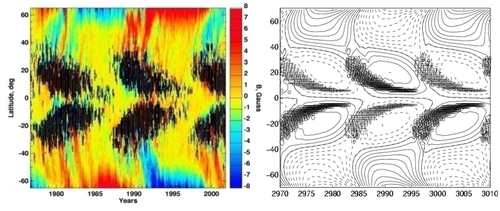Magnetic dynamos and Solar cycle
It is now well recognised that the magnetic fields on the Sun are the basic cause of this variability. Solar dynamo models that can predict the solar cycle are now possible (Choudhuri et al. 2007). Understanding how the magnetic fields are generated and maintained on the Sun, i.e. understanding the solar dynamo, hence, is basic to understanding the origin and nature of solar cycle and variability, and to predict in advance its behaviour both on short and long time scales.
Micro- and macro physics of magnetic dynamos

Ever since Parker (1955) formulated the turbulent dynamo theory, varieties of very different dynamo models for the Sun have appeared in the literature. Global dynamo models, based on Parker's original ideas on the contributions of cyclonic convection and differential rotation, depend a lot also on the micro-physics associated with turbulent interaction and diffusion of magnetic fields throughout the solar convection zone. These processes are the most vigorous in the observable photospheric layers. Studying energy and momentum coupling between radiation, convection and magnetic fields in these layers is crucial to understand near-surface contribution to the overall working and sustenance of the solar dynamo.